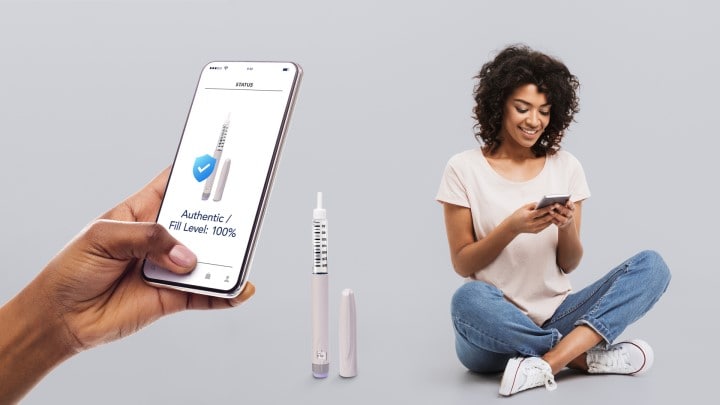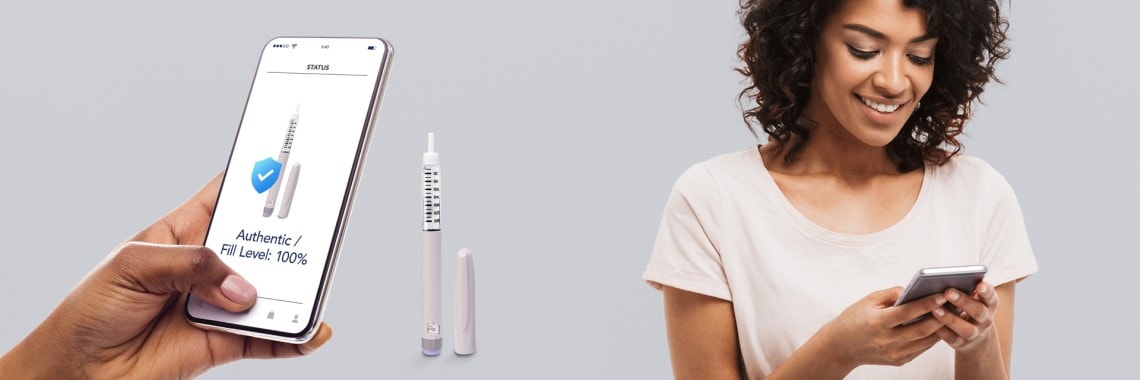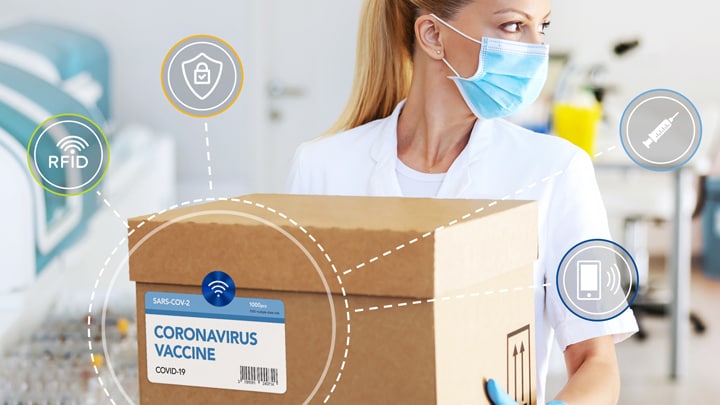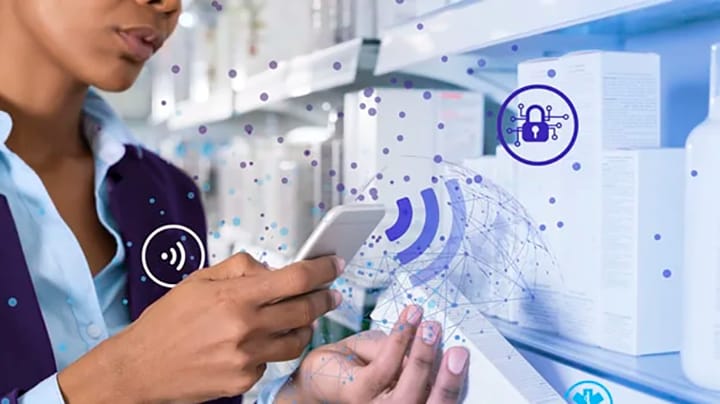Pharmaceutical companies are using Near Field Communication (NFC) with tags
integrated into pharmaceutical labels, packages and delivery devices in order
to address two different but equally important challenges in medication.
In one instance, they’re using the advanced security and tamper-detection
features of new NFC tags to assure identity and safety in the supply chain, so
it’s easier to confirm the authenticity of a medication and verify that it’s
safe to use.
At the same time, pharmaceutical companies are using the latest NFC features
to improve medication delivery and increase adherence, making it easier for
patients to follow dosing regimens and manage chronic illnesses.
NXP’s recently announced
NTAG 22x DNA
and
NTAG 22x DNA StatusDetect ICs, both of which are well-suited for both use cases. These latest additions to
NXP’s already extensive portfolio of NTAG solutions are ready for mass-volume
implementation and offer certified security with battery-less sensing to
support tamper detection and other functions, such as liquid fill level
monitoring.
In this blog, we take a closer look at how NTAG IC advancements can protect
the integrity of pharmaceuticals while making it easier for patients to use
medications more effectively through intelligent delivery systems.
Ensuring Originality and Safety
Today’s pharmaceutical companies struggle to protect their supply chains from
the presence of counterfeit products and illegally diverted drugs. The World
Health Organization (WHO) estimates that counterfeit medicines worth
73 billion euros
(USD 79.26 billion) are traded annually. In a comprehensive
report from 2017, the WHO estimated that 1 in 10 medical products circulating
in low- and middle-income countries were either substandard or falsified. This
problem has only grown more widespread since then, as global supply chains
become more complex, meaning products manufactured in one country may be
packaged in a second country and distributed across borders to be marketed or
sold to consumers in a third. The growth of e-commerce also contributes to
this trend by making it easier to purchase medicines online, often from
unauthorized sources. This can result in health risks and loss of trust for
the consumer, can impact revenues and can cause reputational damage to the
brand owners. In 2020, the WHO identified the
issue of counterfeit drugs as one of the urgent healthcare challenges for
the next decade, reporting counterfeit products from all regions of the world.
Watch our on-demand webinar about smart and secure NFC solutions for healthcare and discover how NFC technology adds value to drug containment and delivery.
NFC Tags Add Security
Pharmaceutical companies are accountable for ensuring that their medicine is
safe when it arrives in the hands of patients. NFC tags help address risks of
falsified or diverted products by adding an extra level of protection—helping
companies manage their supply chains beyond mere serialization. Each tag has
its own unique identity with other built-in electronic functionalities and can
be tracked throughout the supply chain, including the last mile to the
patient, thereby creating a traceable, verifiable provenance. Counterfeits
become easier to spot, since anyone—brand inspectors, pharmacists and
consumers—can confirm product authenticity by simply tapping the label or
package with their phone, even without having to download an app. Patients can
play a part in verifying their own medication and can become more deeply
engaged with their medication supplier by taking advantage of on-demand access
to dosage instructions, new product updates, recognition of side effects,
digital tools and more.
 Ensuring medication's authenticity with NFC
Ensuring medication's authenticity with NFC
NXP Takes Tag Security to the Next Level
With the new NTAG 22x DNA and NTAG 22x DNA StatusDetect, security goes to the
next level. Each IC is Common Criteria-certified to EAL3+ and uses Secure
Unique NFC (SUN) message authentication with AES-128 cryptography, so taps
cannot be cloned. In the NTAG 22x DNA, mutual authentication can add an extra
layer of protection, making it that much harder to carry out unauthorized tag
access or malicious status changes.
The NTAG 22x DNA and NTAG DNA 22x StatusDetect can also detect tampering, so
it’s harder to steal, dilute or replace genuine products. Tamper detection can
use one of two methods: conductive or capacitive. The choice depends on the
implementation, so developers have greater flexibility in their designs.
- Conductive Tamper Detection:
A conductive tamper detection tag uses a conductive loop that, when broken,
irreversibly writes the “once opened” status into the chip’s memory and
sends the open status to the cloud (as part of a secured NFC message) - all
with the tap of an NFC-enabled phone. It’s an ideal way to protect any
labels or seals affixed to the product.
- Capacitive Tamper Detection
With capacitive tamper detection, upon readout, the tag measures the
capacitance and compares it to pre-configured limits. When these limits are
exceeded, the “open” status is added to the secured NFC message. The
capacitive approach is well-suited for integration into physical products,
such as caps, and is also harder for fraudsters to reconstruct.
The combination of certified security and dual-mode tamper detection in the
NTAG 22x DNA and NTAG 22x DNA StatusDetect helps pharmaceutical companies
safeguard the supply chain, protect their brands and combat counterfeiting,
while also making it easier for inspectors, pharmacists, healthcare
professionals and consumers to prove the originality, origin and integrity of
a medication – all with the tap of a phone.
Managing Chronic Conditions
Beyond the presence of counterfeit and illicit drugs, another challenge for
the healthcare industry as a whole, and pharmaceutical companies in
particular, is the global increase in chronic conditions, and how best to
treat the growing presence of persistent, long-lasting illnesses.
According to the ongoing international
Global Burden of Disease (GBD) study, chronic conditions represent some of the most significant trends in
human health. In their
report from 2019, the GBD found that chronic conditions have increased steadily over the
past decade and now account for millions of deaths worldwide each year. They
report that metabolic conditions, which include obesity, diabetes,
hypertension and high cholesterol have had the greatest cumulative impact on
health, but other long-term conditions such as asthma, arthritis and mental
disorders are also on the rise. Treatments for chronic illnesses typically
involve long-term use of one or more medications, and patients are often
dealing with multiple chronic conditions at once.
 Boosting medication adherence with NFC
Boosting medication adherence with NFC
Staying on track with one’s therapy isn’t always easy. Patients don’t always
get prescriptions filled on time, don’t always understand the directions for
proper dosing and don’t always remember to take medications on time. This
problem of not following courses of treatment accurately, in what’s known as
medication adherence, has been a recognized issue in healthcare for some time.
The WHO Health Report 2003 and a number of other studies show that, in
developed countries, patients with chronic conditions have adherence rates of
50% - 60%. Lapses in medication adherence not only lead to adverse health outcomes
for individuals, but have the broader impact of raising everyone’s healthcare
costs.
To help manage adherence and improve patient outcomes, companies are adding
digital capabilities to their drug-delivery devices. In 2018, the research
group Fortune Business Insights reported that the
market for global connected drug-delivery devices stood at USD 361.1
million, and projected it would grow to USD 4,062.7 million by 2026, a
compound annual growth rate (CAGR) of 35.4%.
NFC Tags Can Boost Adherence
Here again, NFC tags can help. When added to a drug delivery system, such as
an injector or inhaler, NFC tags can improve patient safety and adherence
whilst enhancing better user experiences.
A simple tap of a phone to a tagged product can create a link to documents and
videos that explain how to use the drug, what side effects to look for,
interactions to avoid and other useful information. Using an app, patients can
also set reminders for their daily treatments.
Adding an NFC reader to a multi-use refillable device can help with adherence
as well. The reader can automatically authenticate the NFC tag on the drug
consumable such as a cartridge to ensure it’s from a trusted source—and when
the tag is encoded with the drug’s expiration date, the device can also
confirm it’s still viable. After each dose, the reader device can record the
action, and the tag can store an incremental counter value. Bluetooth®
connectivity can ensure data can sync with a patient’s mobile app or store it
in the cloud, so users can track their adherence history and can get
personalized feedback. With patient permission, information can also be shared
with the patient’s healthcare providers.
Learn more about how pharmaceutical companies can use
NFC to boost safety and medication adherence.
NXP Makes Adherence Even Easier
With the NTAG 22x DNA StatusDetect, additional applications become possible.
The battery-free ICs can use their capacitive sensing interface to detect
changes in environmental conditions like moisture or liquid fill level.
Changes in capacitance are captured with an NFC phone upon a tap and
interpreted with a software application. For instance, if values are outside a
pre-defined range, users can monitor things like moisture or liquid fill
level.
Battery-free capacitive sensing means you can tap an NFC-enabled, smart
bandage and assess its level of moisture, without having to remove the bandage
- which could assist in wound healing. Or, you can verify the fill level of a
smart injectable dose monitoring device such as a syringe to ensure medication
is taken properly. Consumers can also check the fill level in opaque
packaging, or receive a reminder for repeat prescriptions via an app, whenever
levels are getting below a threshold. The alert can even link to an authorized
site for ordering so patients can be certain they’ll buy from a genuine,
trusted source.
Simple, scalable digital condition sensing has another use, too, in clinical
studies, where it can be used to achieve compliance and generate trustworthy
results.
 Making medication adherence easier with NFC
Making medication adherence easier with NFC
The Latest in a Leading Portfolio
The
NTAG 22x DNA
and
NTAG 22x DNA StatusDetect
offer several compelling benefits when it comes to protection and adherence,
but they’re just one part of NXP’s broader approach to using NFC tags in the
pharmaceutical and medical-device industry.
For example, our
NTAG SmartSensors
combine NFC with an Arm® Cortex® M0+ processor
and integrated sensor for even more advanced capabilities, such as intelligent
temperature monitoring. An injection pen can signal when a dose is at room
temperature so the injection is less painful to administer. Or, the vial
containing a vaccine that requires careful handling can generate a detailed
data log that proves the vaccine has been kept at the right temperature in the
cold chain and is still viable. These kinds of logs can be used to fine-tune
fulfillment by identifying any systemic handling issues in the broader supply
chain or at the point of care.
What’s more, the NTAG portfolio is only a portion of what NXP offers for NFC
in the IoT. As a leading provider of NFC solutions of all kinds, we remain at
the forefront of the technology. For example, we offer passive IC tags (with
both proximity and vicinity read ranges), connected IC tags, sensing IC tags,
certified secure elements and reader ICs. Together, they create IoT
deployments that let devices connect, sense, think and act.
Learn more about how we're using
NFC and NTAGs
to help pharmaceutical companies help patients by downloading the latest
NTAG 22x DNA and NTAG 22x DNA StatusDetect brochure.







